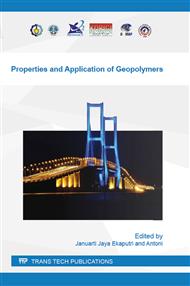p.59
p.65
p.72
p.79
p.83
p.90
p.98
p.104
p.111
Performance of Blended Fly Ash (FA) and Palm Oil Fuel Ash (POFA) Geopolymer Mortar in Acidic Peat Environment
Abstract:
This paper presents performance of blended geopolymer mortars prepared from fly ash (FA) and palm oil fuel ash (POFA). Both materials are used their Si and Al elements were activated by alkaline solution. The alkaline solution was prepared by mixing sodium silicate and sodium hydroxide. The optimum mix proportion of geopolymer mortar with FA:POFA mass ratio was 90:10. The ratio of sodium silicate solution to sodium hydroxide solution by mass was 2.5:1. The mass ratio of sand to blended ashes was 2.75:1. The mortar specimens were prepared using 5×5×5 cm cube and cured at room temperature (28oC) for 3 days before subsequently heat-cured at 110oC for 24 hours. The specimens were immersed in distilled water and peat water with pH 4-5 for 120 days. The compressive strength change, porosity, and sorptivity tests were taken. In general, the results shows there was a decrease in strength, an increase in porosity and sorptivity of the blended geopolymer mortars. Fourier Transform Infra Red (FTIR) test revealed that interaction of geopolymers mortar with the acidic peat water can also cause replacement of the exchangeable cations (Na, K) in polymers by hidrogen or hydronium ions. Formation of some new zeolitic phases in blended FA-POFA geopolymer mortar exposed to acidic peat water were observed.
Info:
Periodical:
Pages:
83-89
Citation:
Online since:
January 2016
Authors:
Keywords:
Price:
Сopyright:
© 2016 Trans Tech Publications Ltd. All Rights Reserved
Share:
Citation:


